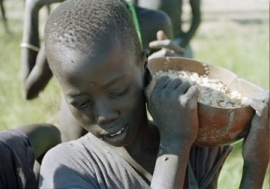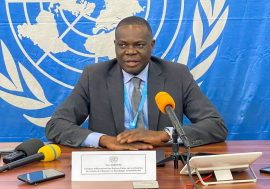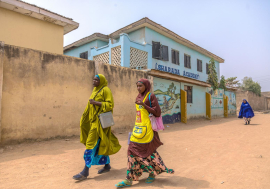A troubled decade for Africa's children
A troubled decade for Africa's children
Over a decade after world leaders gathered at the 1990 World Summit for Children to set ambitious targets for improvements in child health and welfare, life for tens of millions of Africa's youngest and most vulnerable inhabitants remains difficult, dangerous and, all too often, tragically short. Despite the unprecedented global prosperity of the 1990s, and modest advances for children in some African countries, children in sub-Saharan Africa are more likely to be ill, less likely to be in school and far more likely to die before the age of five than children in any other region. Trapped in a downward spiral of war, disease and deepening poverty, African children and their parents were, by some measures, worse off at the end of the decade than they were at the beginning.
"African children have the worst life chances in the world," noted the past Organization of African Unity Secretary-General Salim Ahmed Salim at a Pan-African Forum for Children in May 2001. "And the gap between the survival rates, the education and the development of Africa's children and the children of other continents is increasing." Narrowing that gap will be on the world's agenda again this May, when heads of state and government convene at UN headquarters for the General Assembly Special Session on Children to assess progress towards the goals set at the 1990 summit. The leaders will pledge to build "a world fit for children" in the new millennium, but nowhere will that be more difficult than in Africa.
Lagging behind
The statistics bear grim witness to the plight of African children. During a decade that saw over 100 countries slash mortality rates for children under five by 20 per cent or more (see graph), the UN Children's Fund (UNICEF) reports, the rate for Africa declined by just 3 per cent overall, and actually increased in nine African countries. The under-five mortality rate for sub-Saharan Africa as a whole, at 175 per thousand in 2000, was more than double the world average of 81 per thousand and nearly 30 times higher than that of children in developed countries.
Statistics for another key indicator of well-being for children and their families, maternal mortality, are equally disturbing. Nearly half of the estimated 515,000 women who die annually from pregnancy or child birth are African. With 1,100 deaths per 100,000 births, African women are nearly three times more likely to die than women in the region with the next highest rates, South Asia. According to a 1995 UN study, one African woman in 13 will die during pregnancy or childbirth. In industrialized countries, the ratio is one in every 4,085.
Chronic malnutrition remains widespread in Africa, and the target of a 50 per cent reduction of malnutrition in children under five is far out of reach. Fully one in three Africans is malnourished and, despite improvements in some countries, the absolute number of hungry children rose during the decade. Statistics on low birth weight reveal that an estimated one in eight African babies -- some 3.1 million infants -- is born underweight each year.
"The snapshot of children's well-being globally on the eve of the special session is mixed," UNICEF Executive Director Carol Bellamy told Africa Recovery. "But the picture for African kids is not so mixed. It is generally not good news."
Every third African child suffers from malnutrition.
Photo : ©UN / Evan Schneider
Not all of the news is bad. Primary school enrolment in Africa rose from 54 per cent in 1990 to 60 per cent in 1998. Important progress has also been made in combating polio in Africa and other developing regions, with just 3,500 cases reported world-wide in 2000 compared to over 344,000 in 1988. Vitamin A and iodine deficiencies, major causes of blindness and mental retardation in children, have also been greatly reduced in Africa over the past decade in the face of sustained eradication campaigns. Guinea worm infections have dropped a remarkable 88 per cent, with most new cases limited to war-torn Sudan.
Even much of the good news, however, is tempered by difficult African realities. While polio has been eradicated in all but 20 countries worldwide over the past decade, for example, 16 of the countries worst affected are African. Primary school enrolment in sub-Saharan Africa, up 6 per cent in recent years, is still by far the lowest in the world, and the gender gap in enrolment, with 7 per cent fewer girls than boys in school, remained unchanged over the past decade.
Immunization against three common killers -- diphtheria, pertussis and tetanus -- stands at 72 per cent of children worldwide, but actually declined in Africa during the 1990s to just 46 per cent of African children inoculated. The slippage has come despite offsetting progress in 13 African countries which have achieved the target of 80 per cent coverage. Measles, another ancient scourge, has declined by nearly two thirds globally over the past decade but remains among the top five killers of African children today. A 1998 UNICEF study found that barely half of African children were immunized against the disease despite the low cost and effectiveness of the vaccine.
Development of a vaccine for another major cause of childhood deaths in Africa, meningitis, has languished for years -- not because of technical difficulties, but because of its unprofitability. In announcing a $70 mn grant from the Bill and Melinda Gates Foundation earlier this year to finance development of the vaccine (see Africa Recovery, June 2001), the head of the non-governmental Programme for Appropriate Technology in Health organization noted that the absence of a consumer market for pharmaceuticals in Africa means "there is little incentive for the private sector to develop the vaccine."
AIDS and war
African children were beset by two other, largely unanticipated calamities during the 1990s: AIDS and war. Of the 580,000 people under age 15 who died of AIDS in 2001, a staggering 500,000 -- nearly nine out of 10 -- were African. Of the 2.7 million HIV-positive people under age 15 around the world in 2001, 2.4 million were in Africa. Tuberculosis infection rates, closely associated with HIV/AIDS, have also soared, from an African incidence rate of 16 per 100,000 in 1993 to 52 per 100,000 at the end of 1999. More than 13 million children worldwide have lost one or both parents to AIDS, over 12 million of them in Africa.
The impact of the pandemic on children has been catastrophic, as those most important to the young -- parents, teachers, doctors, peers and siblings -- fall ill and die, causing close-knit families and communities to disintegrate. In the hardest hit countries, said Ms. Bellamy, AIDS has weakened the state. "I'm not talking about the disease itself, but its impact through the loss of health workers and the implications for the delivery of health and other essential services." Health services in particular, she noted, "generally are less effective now than they were 10 years ago in a good number of countries." For many children the loss of parents means a plunge into absolute poverty, the end of formal education and diminished prospects for the future as economies shrink and the hard-won development gains of decades are rolled back.
War too has wiped out advances for children in many African countries. In his report on progress towards the goals adopted at the 1990 summit, Secretary-General Kofi Annan noted that, at the time, "the cold war had recently come to an end and there was great optimism about a new era of peace." With peace would come an end to the economic and social dislocation of war, reduced military budgets and greater resources to invest in children. Instead, he continued, "the world was plunged into a decade of ethnic conflict and civil wars that was characterized by deliberate violence against children on a vast scale. Perhaps more children have suffered from armed conflicts and violence since the summit than at any comparable period in history."
The international community's goals for children have "fallen short largely because of insufficient investment," says UN Secretary-General Kofi Annan.
Nowhere has conflict had a more devastating impact on African children than in the eastern region of the Democratic Republic of Congo, where estimates of the number of war deaths since fighting began in 1998 reach as high as 2.5 million -- the great majority of them women and children. In 1999 the UN High Commissioner for Refugees reported that six of the 10 countries generating the largest number of refugees were African, and that overall, more than 6 million Africans had been displaced because of conflict.
Children are not only the targets of violence, but also its perpetrators, press-ganged into government and rebel militaries alike and sometimes forced to commit brutal atrocities against members of their own families (see Africa Recovery, October 2001). The non-governmental Coalition to Stop the Use of Child Soldiers estimates that children aged 15 and younger are currently engaged in combat in 10 African countries and serve on active duty in others.
As Mr. Annan noted in his landmark 1998 report on the causes of conflict in Africa, war affects virtually all of the social and economic issues affecting children. Vital health and education services are paralyzed. Scarce development resources are diverted to war. Entire communities are uprooted and impoverished by the loss of livelihoods -- leaving particularly women and children vulnerable to sexual assault and exploitation, hunger and disease. The conflicts that consumed some regions of Africa during the 1990s were an important brake on the progress of many children. The debilitating effects of the past decade's wars on them, their families and their countries' development prospects will linger long into the next.
'Insufficient investment'
The single greatest obstacle to the advancement of children in Africa and other developing regions, the Secretary-General's report asserts, is poverty. During the 1990s, the World Bank estimates, about 70 million Africans joined the ranks of the absolute poor, bringing to some 300 million the number of African children and their parents on the very margin of survival. A 1998 study in countries containing 60 per cent of Africa's population found that over half of those surveyed subsisted on an income of just 67 cents per day. It is not surprising therefore, that Africa's children failed to keep pace with children in other regions.
The problem, Mr. Annan's report makes clear, has not been the absence of money, but the lack of will. "At a time of unprecedented global prosperity some 1.2 billion people live in what the World Bank categorizes as absolute poverty, stripped of all human dignity as they struggle to survive on $1 a day in conditions of almost unimaginable suffering and want. Half of them are children." The international community's failure to reach its goals for children was "not because they were too ambitious or were technically beyond reach," the Secretary-General's report concludes. "It has fallen short largely because of insufficient investment."
That lack of investment has fallen hardest on the children of Africa. Part of the fault, says Ms. Bellamy, lies with African leaders. "African countries have to take the lead and invest in children. Unfortunately there are too many countries, even the poorest and most strangled by debt, that are engaged in war. Leaders have to make choices and some of those choices have not been to invest in their people." Women, whose fates are most closely tied to those of their children, continue to suffer economic and social discrimination and political marginalization. Many senior African leaders were slow to recognize the seriousness of the AIDS pandemic and to assume leadership of education and prevention programmes.
According to the industrialized countries' Organization for Economic Cooperation and Development (OECD), during the 1990s developing countries devoted only 12-14 per cent of their national budgets to the basic social services -- health, education, nutrition, sanitation and clean water -- that benefit children most. This is well below the 20 per cent target for spending on social services set in 1995 at the World Summit for Social Development.
The same criticism can be made of the leaders of many industrialized countries, who benefited from a decade of unprecedented prosperity in the North but failed to arrest the growing impoverishment of Africa and its children. Indeed, in the view of many African leaders, economists and civil society advocates, the inequities of the new global economy, including the debt burden, Northern trade barriers, a lack of investment capital and declining aid, have only accelerated Africa's marginalization and further damaged the prospects of its children. In their view, African children's "failure to thrive" over the past decade mirrors the continent's failure to thrive economically during the booming 1990s, despite the promised benefits of open markets and free trade.
In spite of the emergence of an integrated, $30,000 billion global economy by the end of the decade, and impressive growth in Mozambique and a few other countries, sub-Saharan African economies overall were stagnant, with per capita gross domestic product declining by 0.7 per cent between 1988-99. As a result, World Bank statistics show, per capita GNP in Africa (excluding South Africa), which had already dropped from $509 in 1980 to $381 in 1990, declined to just $323 by 1999. The drop in economic activity was reflected in another important measure of well-being, per capita consumption, which declined from $324 in 1990 -- less than a dollar per day -- to only $281 in 1999.
Growing gap between rich and poor
Africa's economic decline was matched by a steady drop in official development assistance (ODA) from wealthy countries. In 1993, some 28 per cent of ODA went to Africa. By 1998 that percentage had shrunk to 24 per cent. Over that same general period, ODA declined from 9.4 per cent of recipients' GDP to 7 per cent. Significantly, according to the Development Assistance Committee of donor countries, the drop in ODA was sharpest in countries with the greatest need -- those with the highest infant mortality, malnutrition and illiteracy rates.
What development aid was available to African countries was, in any case, rarely directed towards children's needs. Only about 10 per cent of ODA over the past decade was earmarked for the basic social services, particularly health and education, that most benefit children. These core services were often targeted for deep budget cuts in the 1980s under the structural adjustment programmes of the International Monetary Fund and World Bank, and remained a low priority for both African governments and donors during the past decade. "That is hard to understand," the Secretary-General's report observes pointedly, "given the international consensus on the benefits of 'investing in children.'"
Africa's ability to finance the development of its children was further compromised by the debt. Between 1980 and 1998 Africa's external debt nearly quadrupled, to over $230 bn, forcing many African countries to pay more -- often much more -- in debt service than for health and education (see graph). Overall, the UN Conference on Trade and Development reported last year, "for each dollar of net capital inflow to sub-Saharan Africa from the rest of the world, a dollar and six cents has flowed out. These figures point to a net transfer of real resources from sub-Saharan Africa to the rest of the world."
As a result, Mr. Annan's report notes, "The gulf between rich and poor countries continues to widen. Between 1960 and 1995, the disparity in per capita income between industrialized and developing countries has more than tripled. Never in history have we seen such numbers. And never have we seen overall aid to the world's neediest countries fall to levels as low as they have in recent years."
Making the world fit for children
If the past decade has produced little progress for Africa's children, there are reasons to hope that the next 10 years will be better. In Mali and other countries (see article "Mali posts modest gains in child health"), government and civil society have forged new alliances to challenge the spread of HIV/AIDS and other diseases, strengthen health and education systems, open up the political process and strengthen transparency and accountability in budgeting and governance. The efforts of individual countries were reinforced by the adoption of an African Common Position by governments and NGOs at the Pan-African Forum on Children in Cairo last year. The statement affirmed children's rights to health, education and peace and declared that "the concerns of children and youth of Africa must be at the centre of the global agenda." African peacemaking and peacekeeping efforts have become more energetic and effective in recent years, improving prospects for an end to the devastating conflicts in West and Central Africa and paralleling the UN's efforts to improve the effectiveness of its own peacekeeping and peacemaking mechanisms.
Externally too, there are modest signs of improvement. In the wake of the failed 1999 World Trade Organization meeting in Seattle, the European Union and the US have slowly begun to open their markets to African exports, reducing tariffs on a growing number of products and expanding technical assistance and capacity building programmes. Debt relief, however halting and fragmentary, has begun to arrive in some of the poorest African countries and is freeing up additional resources for children. In Uganda, for instance, savings from debt relief are financing expanded primary school education and a national campaign to close the enrolment gap between girls and boys.
Despite the economic shock of the 11 September 2001 attacks on the US and the deepening global recession, reform of the multilateral financial system and increased support for AIDS prevention and treatment programmes in Africa remain on the international agenda. This is true in part because a global coalition of Northern and Southern non-governmental organizations and civil society groups has emerged to press wealthy governments and international financial institutions to expand debt relief, increase development assistance and put poverty reduction at the heart of the world economic system. Whether African governments, their donor partners, and the private sector can generate the resources and the political will to build a sustainable economic base for the progress of Africa's children, however, remains to be seen.
In 1990, the international community declared, "Together, our nations have the means and the knowledge to protect the lives and to diminish enormously the suffering of children." Twelve years later it is clear that, in fundamental ways, world leaders failed to deliver on their promises to improve the lives of Africa's children. Whether they will muster the means and apply the knowledge to make good on their promises this time also remains to be seen. African children and their parents will be watching.
















